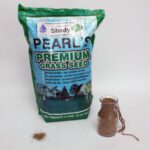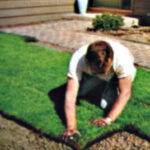When your grass looks horrible and is beyond repair sometimes the only option is using sod as a replacement for your grass. Sometimes people just prefer to set up their lawn by planting sod. The question is how does anybody plant sod and what are the steps?
Sod, grass that is planted previously and harvested for use in other locations other than the farm, needs to be planted as soon as it arrives on location however if its necessary to wait a few days then store the sod in a shed or some shelter that will keep it cool and keep it moistened.
Purchasing sod:
When you’re ready to buy something it’s important to look around for a reputable dealer. A good place to do that would be online or in your phone book. the average sod parcel is between 5-9 feet. A good site to start at would be http://www.allaboutlawns.com/green-pages/index.php.
Once you’ve looked at the place near you, a good estimate of how much a new lawn would cost is between 14 cents and 60 cents per square foot which is fairly expensive considering you could go much cheaper with seeded lawns. This price does not include the estimate of your lawn preparation.
Setting up your lawn:
Plants always needs loose soil so that they can get their roots into the ground, use some sort of equipment like a rake and loosen the soil. Move all the rocks and sticks etc out of the way. be sure that the area is level and the soil level is below the curbs at approximately 3/4 of an inch. This holds true for sidewalks and driveways too. Be sure to put down fertilizer on the soil prior to putting down the sod. Using the rake, continue to spread the fertilizer working it into the soil.
Be sure your fertilizer has the proper nutrition’s for your sod, it depends on what sort of sod you’ve chosen to put down but when you go and purchase your sod, ask the person selling it to you what kind of fertilizer you should be looking for. Quite often, 10-10-4 and 10-6-4 are complete fertilizers and those numbers stand for 10 portions of nitrogen, 6 portions of phosphorous, and 4 portions of potassium. Before putting down your sod, be sure that your soil is moist and fresh.
Laying down the sod:
Once you’re ready to lay down the sod, start at a corner and work your way out and down. Be sure that all of your parcels are flat and do not overlap. They need to be tightly packed so there aren’t any spaces between the sod which would cause uneven surfaces. If you overlap sod, it will cause issues in the growing of the grass. When you lie down your sod, be sure to know that the color difference will not be there eventually, it’s temporary and nothing to be concerned about. Be sure to water your sod immediately that way you’ve given it a good set-up.
For the first 10 days, keep a close eye on your grass and be sure that you give it enough water daily so it doesn’t dry out. Once 10 days has passed, you may mow the lawn however you don’t want to be mowing a lawn with a bad blade. Check your mower and be careful as you mow the lawn. Do not use any chemicals on your lawn for the first year and be sure to fertilize it regularly. (once every six months for the first year).
Enjoy your new lawn!


